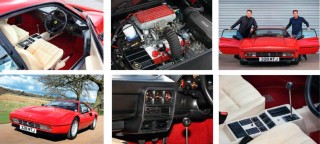We all know how the restoration of an old Ferrari goes. Owner buys car (sometimes unseen), deposits it at a specialist, then returns after 16 months to pick up the not insubstantial tab and their ‘brand new’ classic car – end of story, nothing more to see here, thank you. In fact, Cheshire-based friends Richard Foulkes and Richard Brindley hadn’t even considered embarking on a rebuild project at all. Their intention had been to buy a car together and have a little bit of fun with it. The best-laid schemes of mice and men…

“A specialist I’d dealt with gave us a heads-up on a Ferrari 328 – that he himself didn’t have the appetite for – down in Enfield,” says Foulkes. “The owner was a Cypriot who’d bought the car in 1996 and built this little garage, almost like a bungalow, in his back garden for it. Since then, the 328 had covered just 1000 miles – bringing the total to 29,000 – and had been on SORN since 2005. He was a busy man and worked abroad, coming back each year to just push it out, take a look and then put it back away again.”
In conditions that were far from ideal – tipping rain, dark, dingy garage – they whipped the cover off, got down on their hands and knees, and set about ‘inspecting’ the Ferrari. “To be honest, we didn’t really have a proper look at it,” explains Brindley. “We just gave it a quick once over and checked the mileage. In fact, we spent more time in his living room in negotiation.” What became abundantly clear was that it was a major wrench for the owner to part with the 328. “He looked like he might cry,” says Foulkes. Nevertheless, they struck a deal and the Ferrari was soon speeding northwards on the back of a truck. Their chosen destination was AE Performance Engineering in Knutsford.
It arrived at proprietor Adam Eyre’s premises in May 2016. “It still had its Stratstone dealer sticker and numberplates,” recalls Eyre, who learnt his craft at the then Wilmslow-based dealer. “I remember thinking, ‘I’ve seen this car before’. I had a look through the service book, and there was my signature. I’d serviced it in both 1993 and ’1994; the first stamp was countersigned by my senior technician, because I’d still been an apprentice at the time.”
Reunited some 22 years later, Eyre set to work assessing the Ferrari. The fact that it had been inactive for a while came as no surprise, but it was equally clear that a service, new brake pads and discs wouldn’t be enough. “It’s very difficult to appraise a car in somebody’s garage,” says Eyre, “and it wasn’t until we put it on the ramp that we began to get an idea of which way to go.”
Having been driven nose first into storage, the back end was scabbier than the front, and this was also reflected in the sogginess of the rear suspension. Despite not having been cleaned for a number of years the body was solid, save for a touch of patina here and there.

“I was a bit daunted by the condition of the car,” admits Brindley. “But we asked Adam to run through it, and tell us what it needed.” It would be July before he got stuck in, and first up the suspension was stripped and rebushed. The Koni dampers were sent back to the factory for refurbishment – better than replacement items, reckons Eyre – and the brake calipers rebuilt. The driveshafts were stripped and bearing carriers cleaned – liberating 29,000 miles worth of grime – the bodies repainted, fitted with new rubber boots and reassembled. “The car itself wasn’t that bad,” says Eyre. “But when I put the refreshed components near it, I thought bloody hell – in comparison, the other parts looked as if they’d come off the Titanic.”
The biggest issue, and the one that proved decisive in the way the project moved forward, was the engine bay foam lining, which was in very poor condition and had been reduced to dust in places: “Because it runs behind the fuel tanks and heatshields, replacing it in situ wasn’t a goer, so the decision was taken to remove the engine.”
And there was another problem. “The foam has to be oil and heat resistant, and isn’t currently available from Ferrari or in aftermarket form,” explains Eyre. “With the engine out I could make card patterns, and I then approached the aircraft industry.” Foam Techniques of Northampton was commissioned to reproduce the material, Adam setting to work fitting it.
Unhappy with his first attempt, he approached a trimmer, who “made an even bigger mess than me”. Finally, an upholsterer with a fearsome bandsaw was able to produce the perfect finish: “We spent a lot of time on the foam, getting it just right, and once sorted it was a big turning point – we were progressing.”
This lengthy and involved process, combined with Eyre’s attention to detail, also had an effect on the 328’s owners. “It just evolved,” recalls Brindley. “Adam would say ‘this needs to be done’ and we’d agree. By that time, we were just so far in.” Of course, the reality is that, like many before them, the gents had caught the restoration bug. “It’s addictive,” adds Foulkes, eliciting a nod of agreement from his fellow owner. “We wanted to be actively involved, and rose to the challenge of trying to have the old bits cleaned and restored rather than buying new parts – organising vapour blasting, collecting and dropping off parts, and helping to source others.”
Original components were refurbished where possible, but others such as the plenum chamber – which was significantly cheaper to purchase new – were replaced with genuine spares from Maranello Classic Parts. “Andrew Stevens there really bought into what we were doing,” explains Brindley. “He was super helpful and professional. What amazed us was the number of parts they had available, down to the correct anodised bolts. The only OE item that we couldn’t get was an oil cap.”
With the engine sitting on a pallet dripping oil, it was clear that it was in need of some TLC. Nothing was done internally, but the compression was checked, valve clearances adjusted and fresh gaskets fitted. Intake and exhaust manifolds were sent for blasting, while the starter and alternator were restored by H Bowers in Stoke. Due to inactivity, the fuel system had seized, the pressure-opening plunger injectors and the metering head being particularly unhappy. After refurbishment, the gents brought the fuel injection pipes back but there was a problem.
“They were a shiny silver,” observes Foulkes.
“Adam identified the fact that they should be gold, so they went back to be done again.” “Ferrari 328s have a problem with the differential,” explains Eyre. “If they don’t do miles, it sits out of the oil so the diff plates corrode and groan going around corners. So out it came, and it was stripped, cleaned, the driveshaft flanges greased and the output flanges zinc plated.”
The comprehensive nature of the replating is indicative of the lengths gone to during the restoration. Take the fuel pump brackets. “You pull them out and discover the zinc has failed,” says Eyre, “so you strip them down and find out there are 15 parts in a single bracket. It comes back replated, you put it back on and the pipe suddenly looks wrong. Anything that wasn’t replated or vapour blasted just looked alien to the car.”
At this stage, it’s worth asking who actually drove this restoration? Both owners are unequivocal when they name Eyre. “Some people are perfectionists,” says Brindley, “but Adam goes way beyond that, and it rubbed off on us.”
With the mechanical side of things nearing completion, matters turned to the interior. “We found a chap who’d worked for Connolly and he said somebody had painted the seats,” remembers Foulkes. “When that was removed and they were cleaned, they were like new. ‘Why on earth would anyone do that?’ he asked. Other than that, the door cards just got a wipe down.”
Final fettling involved the alloy wheels being refurbished and the exhaust vapour blasted, while fresh rubber was sourced directly from Pirelli. The car was finally finished a couple of days before our arrival for this photo-shoot. The end result is a smartly presented, original-looking 328 that wears its exterior patina – the odd crack in the paint and minor battle scar – with pride, but which is immaculate mechanically as well as underneath and inside. In fact, much of the effort that’s gone into the project remains hidden from the eye.
“I wouldn’t call it a restoration,” says Eyre, handing me the keys. “It’s more of an elaborate recommissioning.” The owners themselves prefer to think of it as an 11-month rolling rebuild. However you describe the work done, the 328 drives beautifully and reminds you of just how usable this generation of Ferrari is. And despite the suspension not yet having been set up, the car feels just as tight and planted as it would have done when it left the Stratstone showroom all those decades ago.
“You know, we’d never even sat in it, or heard it running until today,” says Brindley. “It wasn’t the intention to carry out a restoration, but all that running back and forth with all those bits has definitely been worth it.”
And they’re both incredibly proud to have kept the car as original as possible. “It would have been dead easy to buy an old scrap car and put all new parts on it,” says Foulkes. “Some people might not appreciate it, but this is the same car – just a better version of it.”
As intimated at the start, the project hasn’t been a typical Ferrari rebuild and that will be reflected when the owners receive their invoice, the breakdown of which will include a multitude of ‘returned to client for refurbishment’ indicators. “The bizarre thing with the whole process is that stuff you think will be reasonably priced is very expensive,” says Foulkes. “We bought a set of bolts – with the original £18 price-tag on the box – for £900, as well as what Adam thinks may be the last new original 328 oil cooler pipes in the world.”
Now that it’s complete, the friends intend to enjoy the Ferrari. “We really are just custodians,” says Brindley. “Someone else will eventually benefit from the level of work that’s gone into it. In fact, given the level of his efforts, and history with the car, Adam really is the buyer for it.” Eyre nods thoughtfully, before stating: “Careful, I haven’t decided what the premium is for those oil pipes, yet.”
Clockwise, from main: timeless profile of the 328GTB is an object of beauty; spotless engine bay; magnolia hide was in excellent condition once paint was removed.
From top: minimal mileage meant that the Ferrari’s bodywork could be left largely untouched; period radio-cassette player plus orange-on-black dials in centre console; trademark open-gate and slender gearlever in pristine cockpit; the prowd owners are now looking forward to using the rebuilt 328.
‘THE REFRESHED PARTS MADE THE OTHER BITS LOOK AS IF THEY HAD COME OFF THE TITANIC’
Rejuvenating an Italian thoroughbred

Clockwise, from right: underside of the Ferrari now looks as good as the rest of the car; refurbished manifolds, fuel-system warm-up regulator and thermostat housing ready to be installed; suspension and brakes were both overhauled, with original Koni dampers rebuilt; 270bhp 32-valve 3185cc V8 was refreshed but thanks to low mileage needed no internal work.





